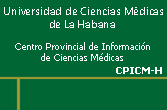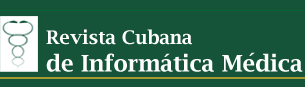| |
Título: TOWARDS INTERNATIONAL CO-OPERATION ON HEALTH INFORMATICS ACTIVITIES; HOW CUBA CAN PLAY A ROLE IN IMIA'S STRATEGIC PLAN AND DEVELOPING WORKING GROUP IN ADDITION TO SPECIAL INTEREST GROUP ACTIVITY.
Autor:
Dr. Peter Murray.
International Medical Informatics Association (IMIA)
Vice President for Working Groups
Special Interest GroupsMember,
IMIA Strategic Plan Taskforce UK representative to IMIA
Coachman’s Cottage
Nocton Hall, Nocton, Lincoln, LN4 2BAUK
Email: peter.j.murray@btinternet.com
Indice
general
Resumen
La Sociedad Internacional de Informática Médica (SIIM) , es el organismo mundial de la informática médica y de salud, y Cuba es desde hace tiempo un miembro nacional.
Los grupos de trabajo de la SIIM (GT) y los Grupos de Interés Especial (GIE) , son el centro de sus actividades científicas regulares y brindan oportunidades a informáticos de muchos países, incluyendo Cuba, a estar activamente involucrados. Como el SIIM alcanza el Cuarenta Aniversario de su fundación, desarrolla un plan estratégico para guiar sus actividades hacia el 2015 y más allá.
Este trabajo tiene doble propósito, primeramente, delinear el Plan Estratégico de la SIIM con su propuesta de nueva visión, guiado por los principios del contexto de trabajo, y por tanto, algunas de sus implicaciones para el futuro desarrollo del trabajo de la SIIM. En segundo lugar, el trabajo delineará los GT y los GIE y cómo los informáticos de la medicina de Cuba y de otras partes puedan involucrarse con la SIIM a través de estos grupos.
Abstract
The International Medical Informatics Association (IMIA) is the world body for health and medical informatics, and Cuba has long been a national member. IMIA's Working Groups (WG) and Special Interest Groups (SIG) are the core of its regular scientific activities, and provide opportunities for informaticians from many countries, including Cuba, to be actively involved. As IMIA reaches the 40th anniversary of its founding, it is developing a Strategic Plan to guide its activities towards 2015 and beyond.
The purpose of the paper is two fold; firstly, outline the IMIA Strategic Plan, with its proposed new vision, guiding principles and conceptual framework, and thus some of its implications for the further development of IMIA's work. Secondly, the paper will outline the IMIA WGs and SIG, and how individuals from Cuba and elsewhere can engage with IMIA through these groups.
Key words:
IMIA; association; health informatics; strategy
.

Introducción
As IMIA, the International Medical Informatics Association, moves towards its 40th birthday in 2007, it is developing a Strategic Plan to guide its aspirations and activities for the period to 2015 and years to come. While the 'IMIA family' is made up of many parts, including national members such as the Cuban Society of Medical Informatics (Sociedad Cubana de Informática Médica – SOCIM), much of its work has been focused around the activity of its Working Groups (WG) and Special Interest Groups (SIG).
This paper outlines the development, and status, of the IMIA Strategic Plan, and shows some of the opportunities for SOCIM and its members to interact with the final development of its Strategic Plan and of future IMIA activities.
It also provides a brief outline of the current IMIA WGs and SIGs, and seeks to encourage the active involvement of individual health informaticians, from Cuba and elsewhere, in developing the work of these groups for the mutual benefit of all.
IMIA – an overview
In 1967, was established the International Medical Informatics Association, IMIA, and so will be 40 years old in 2007. IMIA today is an inclusive organization that represents the biomedical and health informatics world through 45 full country members. As well as over 30 countries whose informatics associations are evolving, through affiliations with the International Federation for Information Processing (IFIP) and the World Health Organization (WHO), and with 10 corporate members, almost 50 academic institutions, and 4 regions of the world. IMIA thus includes over 140 significant entities across the world.
IMIA is an 'organization of organizations', and as such, does not have direct individual membership, unlike national health informatics societies such as SOCIM and the British Computer Society (BCS) Health Informatics Specialist Groups. However, individuals can become members of WGs, and so play an active role in the development of many of IMIA's activities. Among its activities and outputs are the triennial Medinfo event, meetings of its
WGs and the triennial Nursing Informatics Congress, the annual IMIA Yearbook and other respected publications, while educational guidelines and a Code of Ethics are just a few of its other developments in recent years.
While IMIA has changed greatly since its formation, from a Technical Committee of IFIP to an independent organization in 1979, has made significant achievements, and has been influenced by the individuals who have held presidential and other senior leadership positions, it has never had a Strategic Plan to guide its development.
IMIA’s current President, Nancy Lorenzi, believes that now is the right time to create a strategic alignment of IMIA’s goals and a framework for the future of IMIA. The development of the IMIA Strategic Plan is based in the acknowledgment that, as information technology continues to change the world, and as health and healthcare are among the most complex fields of knowledge and as such are among the most likely areas to be transformed by the use of informatics concepts and tools, so the relevance of health informatics will increase in the years ahead as it has increasingly becomes a tool for better understanding biological processes, better distributing healthcare services and providing better education to health professionals.
IMIA has a major role to play in leading the way globally in the development of health informatics, and in order to fulfill this role, it needs to strategically plan action for the years to come, directing its efforts to reach its goals.
The IMIA Strategic Plan (Towards IMIA2015) – the current status
The process of developing the IMIA Strategic Plan began in early 2004. A survey of all IMIA members sought their views of how IMIA would look and what it would be doing in 2010, its strengths and the benefits of membership, and how it might have changed to achieve these. The initial findings were presented to the IMIA Board and General
Assembly at Medinfo 2004 in San Francisco, USA and a Strategic Planning Task Force was established 1 [note1].
The Strategic Planning Taskforce, through a series of face-to-face meetings and through virtual collaboration, has developed a new vision, proposed guiding principles, and an integrated strategic framework model, collectively titled ‘Towards IMIA 2015’. The vision sees IMIA’s role as one of providing leadership and expertise in health informatics to the multidisciplinary health community and policy makers in order to enable the transformation of healthcare in accord with the vision of improving the health of the world population.
IMIA will seek to fulfill its vision by:
• being the informatics association through which the world’s knowledge leaders come together to effectively and efficiently create, assemble, integrate, synthesize or assimilate the intellectual knowledge that is required worldwide to advance Biomedical/health informatics in its role of improving health and healthcare, and
• being the informatics association that effectively and efficiently connects people and the nations of the world to be able to accomplish the above purpose.
A set of guiding principles underpins the strategic framework, these being that:
1. IMIA will help to ensure a holistic, systems approach to collaboration and networking about health informatics to maximize its impact world-wide.
2. IMIA will uphold an ethical approach to informatics systems as identified by IMIA’s seven ethical principles.
3. IMIA will promote health informatics based on evidence and best practice to ensure impact on health is high quality, safe, efficient and sustainable and that makes it easy to do the right thing, in the right way, at the right time world-wide. 2
The framework model (also known as the IMIA rainbow umbrella - figure 1) seeks to represent, in visual and descriptive terms, the various possibilities that exist forconnections and integration. Knowledge has been seeing as the central core of IMIA, with all the strategies, interactions and efforts emanating from this knowledge core. Using a concentric circle model, the next circle (from the central core) represents the science circle, which is followed by the application layer circle, then the impact layer/circle and finally the outermost circle represents the people layer. Another dimensionality of the IMIA Strategic Plan is the need to represent various key sectors.
There are six sectors superimposed on the five concentric circle layers of IMIA’s integration and connection to others (see figure 1).
These sectors represent IMIA’s aims, which are:
• To improve biomedical research, clinical practice and public health (health – the vision);
• To support investigation and development of advanced information systems and technologies (research/science);
• That its efforts are carried out in accordance with strict ethical and legal rules (behavioural responsibility);
• To promote education for and about informatics (education);
• To bridge relevant internal and external groups and organizations (relationships);
• To incorporate multiple individuals, groups and organizations to constitute the IMIA Association (reach).
Figure 1 The IMIA Integrated Strategic Planning Framework (from IMIA SPTF, 2006) Knowledge is the central core of IMIA, and thus is in the center of the model, with all the strategies, interactions and efforts emanating from this knowledge core.
The second circle (from the central core) that directly touches the knowledge core represents the science layer. It is within this layer that IMIA members have their connection and integration with the science and discovery of informatics.
The third circle represents the application layer of the scientific discoveries. It is within this circle that applications that address the multiple questions and issues in informatics are created and disseminated.
The fourth circle represents IMIA’s impact layer. This refers to the potential impact that IMIA and its members can have on governments, nations, outcomes, health professionals, etc.
The fifth, and outermost, circle represents the people layer. Items in this circle include individuals, citizen organizations, personal health involvement, dissemination and acceptance, enabling personal responsibility, and public/personal health.
Another dimensionality of the Strategic Plan is the need to represent various key sectors that IMIA as an international association must address. Superimposed on the five concentric circle layers of IMIA’s integration and connection to others is further are six major sectors. Knowledge is at the center of each of the six sectors. At the top of the circles is the health sector. Since our vision is to improve health this sector represents our vision and thus our strategic goals support this sector. This sector contains pathophysiology (in the science layer); diagnosis, therapy, treatment (in the application layer); public health and health improvement (in the impact layer) and personal health (in the people layer).
The next section is research/science (evidence) (how we understand and create to support health). Within this section we have the following: basic core research (within the science layer); applied science (within the application layer); evaluation (usability) and outcomes (within the impact layer); and dissemination and acceptance (within the people layer).
This is followed by the behavioral responsibility (ethics) sector that refers to our ethical and social responsibility. Within this sector we see the following layers: ethics (within the science layer); legal/regulation (within the application layer); socio-economic (within the impact layer) and personal responsibility (within the people layer).
The next sector is education (best practices) (educating ourselves and others). Within this layer we have the following: health informaticians (within the science layer); implementers (within the application layer); health professionals (within the impact layer) and people education (within the people layer).
The next sector represents the multiple types of relationships (communications and connections (our responsibility to build relationships among stakeholders). Within this sector are the following layers: academic (within the science layer); rofessional (within the application layer); governments/agencies (within the impact layer); and citizen organizations (within the people layer). The sixth sector is the reach (equity) of IMIA (our obligation to share, distribute and disseminate). The layers within this sector are as follows: global (within the science layer); regions (within the application layer); nations (within the impact layer); and individuals (within the people layer).
Further developing the IMIA Strategic Plan
It is said that ‘In the face of complex issues and dilemmas, the ability to navigate through conflicting values and multiple public opinions and professional advice form a variety of players, which reflects diverse community interests, all of which are carried out in the "fishbowl" which is the modern public service. It requires commitment to the public good, but also patience, courage and stamina’ 3 While developing a Strategy by committee, or through an open process, is difficult, if it is to be owned and accepted by the IMIA ‘family’, then all its members must be able to assist in its development and agree with the final vision and detail.
An open and transparent process of debate and dialogue will be instituted; to which all members will have the opportunity to contribute.
The Strategic Framework and Plan will have been be discussed by the IMIA General Assembly (GA), its governing body, in November 2006. If the IMIA GA agrees to the overall Strategic direction, then there will still be a great deal of work in completing the detail of the specific objectives and tasks to be undertaken in realizing the Strategic vision.
All IMIA members and those with an interest in the future direction and scope of the world body for health informatics are invited to participate in the next stages. The Strategic Plan hags' implications for the nature and scope of all IMIA's current elements, and in particular its WGs. The Strategic Plan provides an opportunity to examine the nature and method of working of IMIA's WGs, and work will be undertaken in parallel with the finalization of the Strategic Plan.
IMIA's WGs and SIGs – an overview
Many people – even nurse informaticians and health informaticians active within their own national organizations - do not understand the relationship between IMIA and their own national organizations, nor how individuals can become involved with the activities of the many WGs.
IMIA currently has 18 WGs (with proposals in development for several others) and one SIG (Nursing) (see table 1). Each WG, as per IMIA statutes, has a particular area of interest and activities.
A full description of each, with links to information on contact details for their chairs, co-chairs, and websites where they exist, is provided on the IMIA website, and updates are provided in the IMIA Yearbook. IMIA WGs vary in the level of their activities, although many hold conferences and other events, and contribute actively to Medinfo conferences and other regular events.
Table 1.
IMIA's Working Groups
Biomedical Pattern Recognition
Biomedical Statistics and Information Processing
Consumer Health Informatics
Dental Informatics
Health and Medical Informatics Education
Health Informatics for Development
Health Information Systems
Informatics in Genomic Medicine
Intelligent Data Analysis and Data Mining
Medical Concept Representation
Mental Health Informatics
Open Source Health Informatics
Organizational and Social Issues
Primary Health Care Informatics
Security in Health Information Systems
Standards in Health Care Informatics
Technology Assessment & Quality Development in
Health Informatics
Telematics in Health Care
Encouraging involvement and activity in IMIA WGs and SIGs
IMIA WGs provide an opportunity for anyone, from any country, who has an interest in the area covered by the scope of a particular WG, to become involved; this is usually through contacting the WG chairs and co-chairs.
As the new Vice President for WG and SIG, I am keen to explore the potential for redefining the scope and activities of IMIA WGs, and to encourage them to more activity that is regular.
They have the potential to be the forums wherein which the leading experts of a subset of health informatics work together to develop the field. A workshop will have been held at the IMIA 2006 GA, and the outputs of this will be reported. It is hoped that it will build on ideas generated from the 2005 IMIAGA in Geneva.

Conclusiones
IMIA is a long-established international organization that brings together many leading organizations and individuals in the health and medical informatics world. It is in a stage of planned and pro-active evolution, through the development of its Strategic Plan, 'Towards IMIA 2015!', which will have many implications for its future shape and activities.
Now is an ideal time to explore the relationship of IMIA's WGs and SIGs to its overall activities, and to explore ways in which individual health informatics experts in all countries can become even more actively involved, and we hope that m\ay will choose to become engaged with the ongoing discussions and developments.
Note
1. The members of the IMIA Strategic Plan Taskforce are:
• Nancy Lorenzi: IMIA President, National Representative (USA) and Academic Representative (VanderbiltUniversity)
• Floyd Eisenberg: Corporate Representative (Siemens)
• H M Goh: National Representative (Malaysia)
• Steven Huesing: Executive Director
• Fernando Martin-Sanchez: National Representative (Spain); Special Interest and Working Group Representative (Genomics Working Group)
• Lincoln de Assis Moura Jr: Regions Representative (Latin America and Caribbean)
• Peter Murray: National Representative (UK); Special Interest and Working Group Representative (Open Source Working Group); Academic Representative (CHIRAD)
• Heather Strachan: Special Interest and Working Group Representative (Nursing Special Interest Group).
Bibliografía
-
Lorenzi NM. The IMIA Possibility Framework, Methods Inf Med, 2004; 43:207.
- IMIA SPTF (Strategic Planning Task Force). Strategy in a fishbowl: an invitation to determine the shape of IMIA in 2015. Methods Inf Med, 2006; 45:235-9.
- Cochrane J. Opening Address, 5th Atlantic Conference on the Future of Public Administration Truro, Nova Scotia - February 5, 2004 http://www.hrmaagrh gc.ca/veo-bve/speeches/cochrane_e.asp
|



